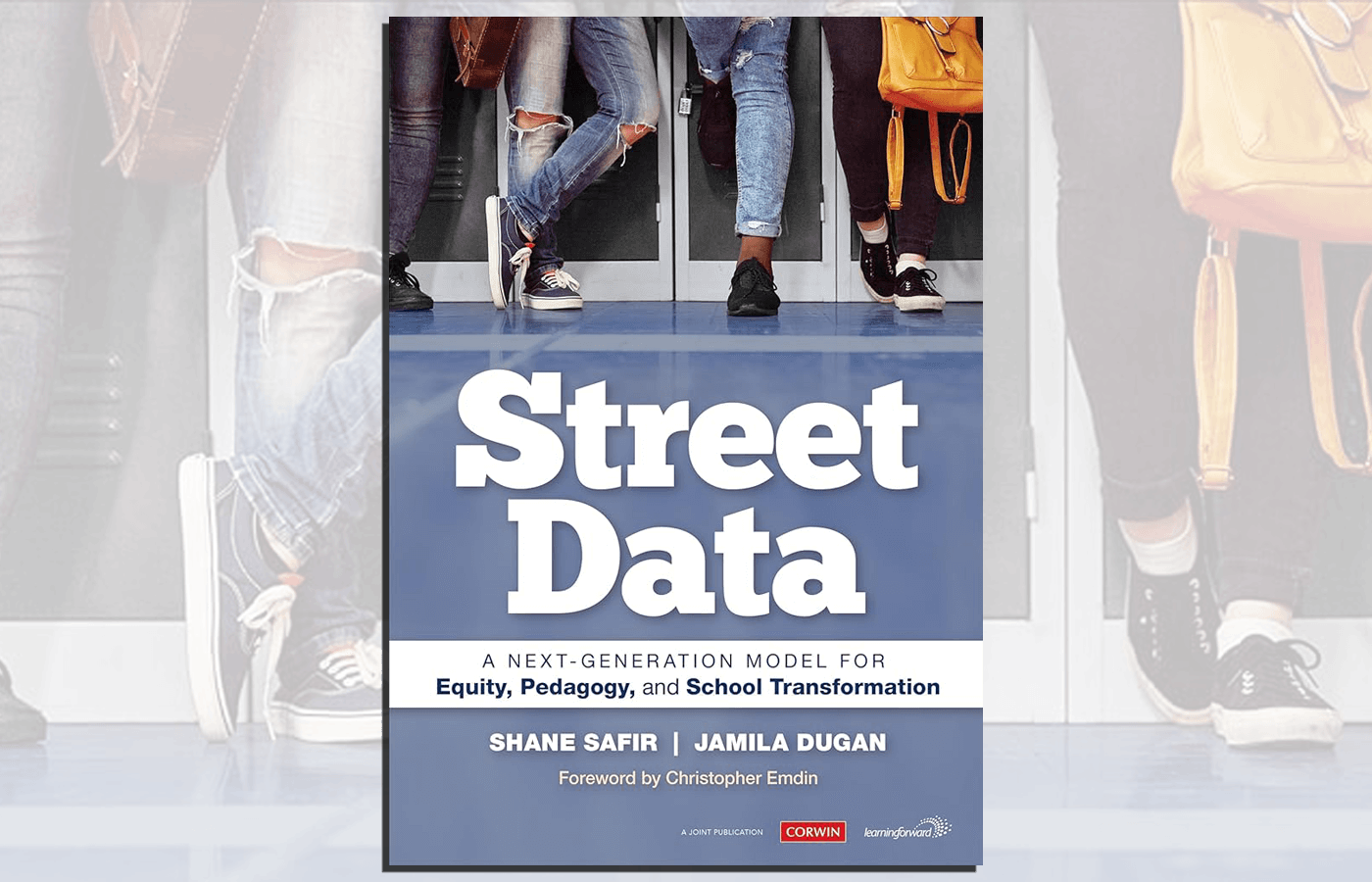
Street Data: A Next-Generation Model for Equity, Pedagogy, and School Transformation
by Shane Safir and Jamila Dugan
Corwin, 2021, $40, 280 pages
As reviewed by Steve Rees
If you pick up Street Data hoping to learn how to make sense of education data, you will be disappointed. Despite its title, Street Data contains hardly any numbers at all. In fact, the book is a frontal assault on the use of quantitative data, especially test scores, and objective empirical inquiry to inform education decisions. Shane Safir and Jamila Dugan, who describe themselves as “diversity warriors,” urge teachers and leaders to stop accepting the use of numbers to measure learning and schooling and to start thinking instead like cultural anthropologists. They urge readers to listen to students and observe their behaviors, with grand ambitions in mind. “The purpose of this book,” they write, “is to offer a next-generation model of equity and deep learning, emerging from a simple concept: street data… Street data embodies both an ethos and a change methodology that will transform how we analyze, diagnose, and assess everything from student learning to district improvement to policy.”
The authors’ zeal for “transformation” and laudable opposition to racism may help explain why the book, published in late 2021, has climbed to the top of Amazon’s sales rankings in the category of education administration. But I suspect the book’s enduring popularity also reflects larger forces at work among education professionals: a deep skepticism of evidence-based decision making and a resurgent movement against standardized testing and accountability policies, which, after all, require counting. That’s worrisome.
What leads “diversity warriors” to oppose empirical inquiry?
Surprisingly for a volume aimed at practitioners, the book begins with a philosophical preface that asks, “How do we know what we know?” The authors assert that we too often reduce our understanding of what we know to that which adheres to “the Western theory of knowledge known as empiricism—which emphasizes the role of sensory evidence and patterns in the formation of ideas rather than innate ideas or traditions—and its relative, the scientific paradigm of positivism.”

Safir and Dugan draw a parallel between early anthropologists’ exploitative research on indigenous people and the way school systems assess student learning. In the authors’ telling, those who measure students are akin to Western researchers who imposed their cultural values on native populations. By extension, tests, surveys, and indicators of student behavior are instruments of control akin to the film footage, notebooks, and photographic records kept by anthropologists. This parallelism isn’t the beginning of their critique of measurement in education; it is the entirety of their argument.
If Safir and Dugan were aiming to persuade readers, they would have constructed evidence-based arguments against testing and other forms of quantitative data collection. Instead they invoke buzzwords and cite sources as if they hold magical powers. To defend their rejection of evidence as a foundation of knowledge, they rely mainly on Afrocentric epistemology, a choice that is both bizarre and unconvincing. Simply affirming “spirituality, communalism, cooperation, ethics, and morality” and African American liberation as a counterpoint to measurement and empirical inquiry is unpersuasive. The book reads more like a hymnal with Biblical citations than a work of scholarship based on reasoned argument. It requires that the reader embrace its assertions as a matter of faith.
What exactly do Safir and Dugan mean by street data? “Street data is a decolonizing form of knowledge that honors Indigenous, Afrocentric, and other non-Western ways of knowing.” They continue: “At the heart of this book lies an existential question: Why do we rely on current forms of data, and what would happen if we simply stopped . . . and embraced a new model?”
Come now. We rely on “current forms of data” to answer important questions about students, teachers, and the policies that structure their work. We rely on those data when deciding to what degree class-sizes affect learning. We rely on them when judging how schools are doing at advancing emerging bilingual students towards English fluency. To call this an “existential question” is hyperbolic. To pose “Indigenous” and “Afrocentric ways of knowing” as being in opposition to empiricism is not just an error of historical interpretation—empiricism was born among the pre-Socratics in Greece and advanced in Egypt—it is racial reductionism. The authors denigrate everything they view as European or “white” while presenting everything not white as praiseworthy. Reasoning this shallow should raise hackles, not boost a book to top-tier sales rankings.
When anti-measurement leads to anti-reasoning
I recall the consequences of the politics of identity fifty years ago, and its reincarnation today seems painfully familiar. I came of age in the 1960s. I enjoyed my years of reading Frantz Fanon, Paolo Freire, Kwame Nkrumah, Leroi Jones, Malcolm X, and more. I joined the Student Nonviolent Coordinating Committee in high school, was a member of Students for a Democratic Society in the late 1960s and was active in the antiwar movement. I have seen where racial reductionism can lead to a biological determinism that reduces all things human to the bodies we are born with. Those who embrace the ideas of Black intellectuals as inherently good because of their “Blackness” become the bigots they decry. Unlike Safir and Dugan, I believe that a heart that beats for a cause and a mind that reasons with numbers and words can coexist in the same body.
I am also lead author of Mismeasuring Schools’ Vital Signs, which makes a case for reducing the misuses and misrepresentations of evidence on students, teachers and schools. And yes, I am an empirical practitioner who supports district and school leaders in making proper sense of the data they possess. It is no surprise that I find myself on the opposite side of the fence from Safir and Dugan on many matters. Yet I agree with some of their observations:
- The focus on achievement gaps has reinforced bigoted ideas (e.g., that ethnicity causes differences in students’ test scores).
- The reduction of human interactions to numbers can become a mania and lead to badly built evidence and wrong conclusions.
- Student voices are too often ignored by those who teach and who lead schools and districts.
- Students’ capabilities often go unnoticed, unassessed, unrewarded.
Even so, I am troubled by Safir and Dugan’s use of simple assertions where they owe their readers arguments. They cite only like-minded authors and seem to be quoting them not to advance an argument but to signify respect. Absent from their analysis is any regard for the value of standardized assessment or the needs of parents and students to validate whether teacher-assigned grades are a fair measure of students’ knowledge and skills. Quite annoying is their unnecessary invention of original terms to create a peculiar meta-language that will soon be understandable only to those who already agree with them.
What does the book’s popularity tell us about teaching?
What concerns me most is the evidence-resistant nature of the K–12 teaching profession and the field of education management. Education scholar John Hattie put the question clearly in his 2008 book Visible Learning. After describing the medical profession’s struggle to mature and its reliance for centuries on simple trial and error to feel its way toward effective diagnosis and treatment, Hattie concludes that “evidence-based medicine was the mechanism for driving out dogma, as dogma does not destroy itself.” He then wonders when education will have its own moment of growing up, its own evidence-based transition: “The key question is whether teaching can shift from an immature to a mature profession, from opinions to evidence, from subjective judgments and personal contact to critique of judgments.”
Street Data’s popularity may be a sign that Hattie’s “key question” will not be answered in the affirmative anytime soon. The debate between those who favor intuitive knowledge (what Safir and Dugan call “innate ideas”) and those who favor evidence-based paths to decisions (the empirical reasoning group) has not yet occurred. Where are the debates at conferences of scholars or practitioners? Where are the debates in print?
Right now, the anti-testing forces appear to be winning. More than two decades of misunderstanding and misusing test results have taken a toll. The pro-testing forces haven’t even established a beach head, let alone returned fire. Not even the test publishers are standing up to defend the proper uses of assessment, though some scholars have: James W. Popham and Howard Wainer, for example. Ellen Mandinach and Edith Gummer have revealed the absence of curricula about assessment and data analysis in schools of education. But advocates of data-driven decision-making have never really faced their adversaries. The arguments of the two sides just sail past each other. Now testing itself occupies a defensive position.
I’m left with Hattie’s question if teaching can “shift from an immature to a mature profession, from opinions to evidence.” Medicine has made the leap. So has baseball. Even statistics had its moment of reckoning, a robust debate lasting nearly 100 years about whether the concept of statistical significance had done more harm than good and had no reason to exist. The debate was settled in March 2019 with a decisive thumbs-down to statistical significance, announced in an editorial and supported by 43 essays. I hope to live to see an equally robust debate over measurement and empirical paths to knowledge in K–12 education. Let’s get started.
Steve Rees is the founder of School Wise Press and its K12 Measures project, and is the co-author of Mismeasuring Schools’ Vital Signs, written with Jill Wynns.


